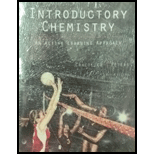
Concept explainers
Write the electronic configuration for the ions of the third period element that form monoatomic ions that are isoelectronic with a noble gas atom. Also, identify the noble gas atoms having those configurations.
Interpretation:
The electronic configuration for the ions of the third period element that form monoatomic ions that are iso-electronic with a noble gas atom is to be stated. The noble gas atoms having those configurations are to be identified.
Concept introduction:
The arrangement of electrons in the energy sublevels is explained by the electron configuration of an atom. The electron configuration of an atom can be written according to the arrangement of energy levels as shown below.
In the modern periodic table, the horizontal rows are known as periods, whereas vertical columns are known as groups. There are
Answer to Problem 1E
The electronic configuration of
Explanation of Solution
An iso-electronic series is a group of ions that contain the same number of electrons.
The elements in the third period are
The atomic number of
The electronic configuration of
The electronic configuration of
The electronic configuration of
The atomic number of
The electronic configuration of
The electronic configuration of
The electronic configuration of
The electronic configuration of
Want to see more full solutions like this?
Chapter 12 Solutions
Bundle: Introductory Chemistry: An Active Learning Approach, 6th + LMS Integrated for OWLv2, 4 terms (24 months) Printed Access Card
- Arrange the following bonds in order of decreasing polarity: CC,CH,CN,CO,CS. State the element that is the negative pole in each. You may refer to Figure 12-15.arrow_forwardA monatomic ion with a 2 charge has the electron configuration 1s22s22p63s23p64s23d104p6. a What neutral noble gas atom has the same electron configuration? b What is the monatomic ion with 2 charge that has this configuration reaction? c Write the symbol of an ion with a 1+ charge that is isoelectronic with the species in a and b.arrow_forwardThe geometric arrangement of electron pairs around a given atom is determined principal by the tendency to minimize between the electron pairs.arrow_forward
- For each of the following atoms or ions, state the total number of electrons, the number of valence electrons, and the number of core electrons. (a) Rn (b) Sr+ (c) Se2 (d) Sb2arrow_forwardA monoatomic ion with a charge of 1 has an electronic configuration of 1s22s22p63s23p6. a Is this ion a cation or an anion? b With what noble gas is it isolectronic? c What is the symbol of the ion?arrow_forwardWhich simple ion would each of the following elements be expected to form? Which noble gas has an analogous electron configuration to each of the ions? msp;a.bromine,Z=35b.cesium,Z=55c.phosphorus,Z=15d.sulfur,Z=16arrow_forward
- In forming an ionic bond with an atom of chlorine, a sodium atom will: a.receive one electron from the chlorine atom. b.receive two electrons from the chlorine atom. c.give up one electron to the chlorine atom. d.give up two electrons to the chlorine atom.arrow_forward• use electron configurations to explain why metals tend to form cations whereas nonmetals tend to form anions.arrow_forwardFirst you need to find the number of valence electrons in NH2Cl. For counting purposes with Lewis structures, the number of valence electrons in an atom of a main group element is equal to the last digit in the group number of that element in the Periodic Table. N is in Group ________ H is in Group ________ Cl is in Group _________ In NH2Cl there is a total of ____________ valence electrons.arrow_forward
 Introductory Chemistry: An Active Learning Approa...ChemistryISBN:9781305079250Author:Mark S. Cracolice, Ed PetersPublisher:Cengage Learning
Introductory Chemistry: An Active Learning Approa...ChemistryISBN:9781305079250Author:Mark S. Cracolice, Ed PetersPublisher:Cengage Learning Chemistry for Engineering StudentsChemistryISBN:9781337398909Author:Lawrence S. Brown, Tom HolmePublisher:Cengage Learning
Chemistry for Engineering StudentsChemistryISBN:9781337398909Author:Lawrence S. Brown, Tom HolmePublisher:Cengage Learning World of Chemistry, 3rd editionChemistryISBN:9781133109655Author:Steven S. Zumdahl, Susan L. Zumdahl, Donald J. DeCostePublisher:Brooks / Cole / Cengage Learning
World of Chemistry, 3rd editionChemistryISBN:9781133109655Author:Steven S. Zumdahl, Susan L. Zumdahl, Donald J. DeCostePublisher:Brooks / Cole / Cengage Learning Introductory Chemistry: A FoundationChemistryISBN:9781337399425Author:Steven S. Zumdahl, Donald J. DeCostePublisher:Cengage Learning
Introductory Chemistry: A FoundationChemistryISBN:9781337399425Author:Steven S. Zumdahl, Donald J. DeCostePublisher:Cengage Learning General, Organic, and Biological ChemistryChemistryISBN:9781285853918Author:H. Stephen StokerPublisher:Cengage Learning
General, Organic, and Biological ChemistryChemistryISBN:9781285853918Author:H. Stephen StokerPublisher:Cengage Learning Living By Chemistry: First Edition TextbookChemistryISBN:9781559539418Author:Angelica StacyPublisher:MAC HIGHER
Living By Chemistry: First Edition TextbookChemistryISBN:9781559539418Author:Angelica StacyPublisher:MAC HIGHER





